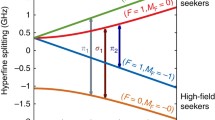Abstract
The ASACUSA collaboration aims to measure the ground state hyperfine splitting (GS-HFS) of antihydrogen, the antimatter counterpart to atomic hydrogen. Comparisons of the corresponding transitions in those two systems will provide sensitive tests of the CPT symmetry, the combination of the three discrete symmetries charge conjugation, parity, and time reversal. For offline tests of the GS-HFS spectroscopy apparatus we constructed a source of cold polarised atomic hydrogen. In these proceedings we report the successful observation of the hyperfine structure transitions of atomic hydrogen with our apparatus in the earth’s magnetic field.
Similar content being viewed by others
References
Parthey, C.G.: Improved Measurement of the Hydrogen 1S −2S Transition Frequency. Phys. Rev. Lett. 107, 203001 (2011)
Ramsey, N.F.: Experiments with separated oscillatory fields and hydrogen masers. Rev. Mod. Phys. 62(3), 541 (1990)
Bluhm, R., Kostelecký, V.A., Russell, N.: CPT and Lorentz Tests in Hydrogen and Antihydrogen. Phys. Rev. Lett 82, 2254-2257 (1999)
Kuroda, N., et al.: A source of antihydrogen for in-flight hyperfine spectroscopy. Nat. Commun. 5, 3089 (2014)
Rabi, I.I., et al.: The molecular Beam Resonance Method for Measuring Nuclear Magnetic Moments. Phys. Rev. 55, 526 (1939)
Kusch, P.: Redetermination of the Hyperfine Splitting of Hydrogen and Deuterium in Ground State. Phys. Rev. 100/4, 1188 (1955)
Wittke, J.P., Dicke, R.H.: Redetermination of the Hyperfine Splitting in the Ground State of Atomic Hydrogen. Phys. Rev 96, 530 (1954)
Essen, et al.: Frequency of the Hydrogen Maser. Nature 229, 110 (1971)
Hellwig, et al.: Measurement of the Unperturbed Hydrogen Hyperfine Transition Frequency. IEEE Trans. Instrum. Meas. IM-19, 200 (1970)
Federmann, S., Caspers, F., Mahner, E., Juhasz, B., Widmann, E.: Design of a 1.42 GHz Spin-Flip Cavity for Antihydrogen Atoms, Conf. Proc., C100523, MOPE054 (2010)
Prodell, A.G., Kusch, P.: The Hyperfine Structure of Hydrogen and Deuterium. Phys. Rev. 88(2), 184 (1952)
McCullough, R.W., et al.: A new microwave discharge source for reactive atom beams. Meas. Sci. Technol. 4, 79 (1993)
Majorana, E.: Oriented atoms in a variable magnetic field, Ettore Majorana Scientific Papers. Ed. by G. F. Bassani, Pisa: Springer , pp 113-136 (2006)
Author information
Authors and Affiliations
Corresponding author
Additional information
Proceedings of the International Conference on Exotic Atoms and Related Topics (EXA 2014), Vienna, Austria, 15-19 September 2014
Rights and permissions
About this article
Cite this article
Diermaier, M., Caradonna, P., Kolbinger, B. et al. An atomic hydrogen beam to test ASACUSA’s apparatus for antihydrogen spectroscopy. Hyperfine Interact 233, 35–40 (2015). https://doi.org/10.1007/s10751-015-1151-y
Published:
Issue Date:
DOI: https://doi.org/10.1007/s10751-015-1151-y




